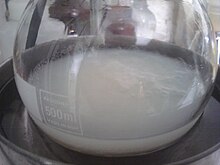The Finkelstein reaction, named after the German chemist Hans Finkelstein,[1] is a type of SN2 reaction (substitution nucleophilic bimolecular reaction) that involves the exchange of one halogen atom for another. It is an equilibrium reaction, but the reaction can be driven to completion by exploiting the differential solubility of various halide salts, or by using a large excess of the desired halide.[2]
| Finkelstein reaction | |
|---|---|
| Named after | Hans Finkelstein |
| Reaction type | Substitution reaction |
| Identifiers | |
| Organic Chemistry Portal | finkelstein-reaction |
| RSC ontology ID | RXNO:0000155 |


Method
editThe classic Finkelstein reaction entails the conversion of an alkyl chloride or an alkyl bromide to an alkyl iodide by treatment with a solution of sodium iodide in acetone. Sodium iodide is soluble in acetone while sodium chloride and sodium bromide are not;[3] therefore, the reaction is driven toward products by mass action due to the precipitation of the poorly soluble NaCl or NaBr. An example involves the conversion of the ethyl ester of 5-bromovaleric acid to the iodide:[4]
- EtO2C(CH2)4Br + NaI → EtO2C(CH2)4I + NaBr
Potassium fluoride is used for the conversion of chlorocarbons into fluorocarbons.[5] Such reactions usually employ polar solvents such as dimethyl formamide, ethylene glycol, and dimethyl sulfoxide.[6]
Use for analysis
editAlkyl halides differ greatly in the ease with which they undergo the Finkelstein reaction. The reaction works well for primary (except for neopentyl) halides, and exceptionally well for allyl, benzyl, and α-carbonyl halides. Secondary halides are far less reactive. Vinyl, aryl and tertiary alkyl halides are unreactive; as a result, the reaction of NaI in acetone can be used as a qualitative test to determine which of the aforementioned classes an unknown alkyl halide belongs to, with the exception of alkyl iodides, as they yield the same product upon substitution. Below some relative rates of reaction (NaI in acetone at 60 °C):[7][8]
| Me–Cl | Bu–Cl | i-Pr–Cl | t-BuCH2–Cl | CH2=CH–CH2–Cl | PhCH2–Cl | EtOC(O)CH2–Cl | MeC(O)CH2–Cl |
|---|---|---|---|---|---|---|---|
| 179 | 1 | 0.0146 | 0.00003 | 64 | 179 | 1600 | 33000 |
Aromatic Finkelstein reaction
editThe aromatic chlorides and bromides are not easily substituted by iodide, though they may occur when appropriately catalyzed. The so-called "aromatic Finkelstein reaction" is catalyzed by copper(I) iodide in combination with diamine ligands.[9] Nickel bromide and tri-n-butylphosphine have been found to be suitable catalysts as well.[10]
See also
edit- Halex process, also a salt metathesis, but for conversion of aryl chlorides to aryl fluorides
References
edit- ^ Finkelstein, Hans (1910). "Darstellung organischer Jodide aus den entsprechenden Bromiden und Chloriden". Ber. Dtsch. Chem. Ges. (in German). 43 (2): 1528–1532. doi:10.1002/cber.19100430257.
- ^ Smith, Michael B.; March, Jerry (2007), Advanced Organic Chemistry: Reactions, Mechanisms, and Structure (6th ed.), New York: Wiley-Interscience, ISBN 978-0-471-72091-1
- ^ Ervithayasuporn, V. (2013). "One-pot synthesis of halogen exchanged silsesquioxanes: octakis(3-bromopropyl)octasilsesquioxane and octakis(3-iodopropyl)octasilsesquioxane". Dalton Trans. 42 (37): 13747–13753. doi:10.1039/C3DT51373D. PMID 23907310.
- ^ B. H. Lipshutz; M. R. Wood; R. Tirado (1999). "Copper-catalyzed Conjugate Addition of Functionalized Organozinc Reagents to α,β-Unsaturated Ketones: Ethyl 5-(3-oxocyclohexyl)pentanoate". Org. Synth. 76: 252. doi:10.15227/orgsyn.076.0252.
- ^ Vogel, A. I.; Leicester, J.; Macey, W. A. T. (1956). "n-Hexyl Fluoride". Organic Syntheses. 36: 40. doi:10.15227/orgsyn.036.0040.
- ^ Han, Q.; Li, H-Y. "Potassium Fluoride" in Encyclopedia of Reagents for Organic Synthesis, 2001 John Wiley & Sons,New York. doi:10.1002/047084289X.rp214
- ^ Streitwieser, A. (1956). "Solvolytic Displacement Reactions at Saturated Carbon Atoms". Chem. Rev. 56 (4): 571–752. doi:10.1021/cr50010a001.
- ^ Bordwell, F. G.; Brannen, W. T. (1964). "The Effect of the Carbonyl and Related Groups on the Reactivity of Halides in SN2 Reactions". J. Am. Chem. Soc. 86 (21): 4645–4650. doi:10.1021/ja01075a025.
- ^ Klapars, A.; Buchwald, S. L. (2002). "Copper-Catalyzed Halogen Exchange in Aryl Halides: An Aromatic Finkelstein Reaction". J. Am. Chem. Soc. 124 (50): 14844–14845. doi:10.1021/ja028865v. PMID 12475315. S2CID 11338218.
- ^ Cant, Alastair A.; Bhalla, Rajiv; Pimlott, Sally L.; Sutherland, Andrew (2012). "Nickel-catalysed aromatic Finkelstein reaction of aryl and heteroaryl bromides". Chem. Commun. 48 (33): 3993–5. doi:10.1039/c2cc30956d. PMID 22422214.